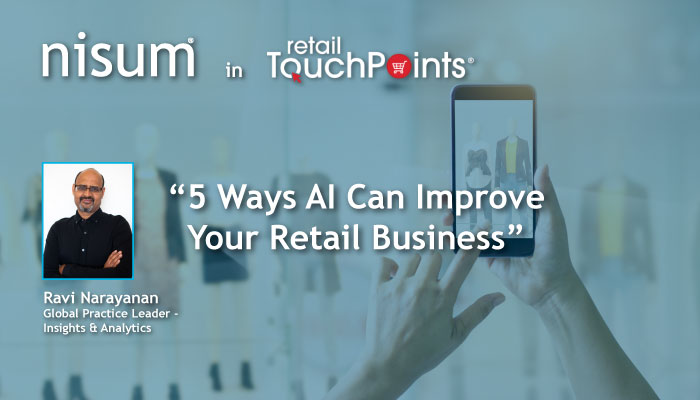In his Retail TouchPoints article, Ravi Narayanan, Nisum’s Global Practice Leader of Insights and Analytics points out that the retail industry is leading global spend on AI and shares five applications of this technology being used to improve customer experience.
Read the text below or view the full article here.

5 Ways AI Can Improve Your Retail Business
If software was eating the world in 2011, it’s safe to say that artificial intelligence has the biggest appetite at today’s table. According to a new report from IDC, global spending on AI will reach $35.8 billion this year and $79.2 billion by 2022.
And leading the pack for global spending on AI in retail. The same IDC report projects that retailers will invest $5.9 billion this year alone on AI-powered solutions. Given that data analytics and AI can be directly applied to help retailers better understand their customers and provide them with more personalized products and services, this makes intuitive sense. But there is also a strong business case here: McKinsey has found that over the last five years, U.S. companies have seen a 19% increase in operating margin due to machine learning.
However, with so much noise in retail around how to leverage AI and data analytics for both front and backend optimization, it’s easy to be swayed by whatever is the newest technology promising to revolutionize your business. It’s critical for retail executives to remember that any sort of AI investment or implementation must be strategy-driven.
Here are some of the applications that are making the most business impact today:
Product Recommendations. When consumers shop in-store, there are often sales associates available to understand what they’re looking for and help navigate the journey to purchase. With the exponential boom in online shopping and services, how will this service be replicated online? Who will understand the customer’s needs and suggest the most relevant products? You guessed it, an AI recommendation system.
The business impact here is quite straightforward: revenue growth. Over 50% of Amazon’s sales are driven through recommendation engines that take into account not only a shopper’s own purchasing behavior but also that of other similar shoppers using item-to-item collaborative filtering. As a result, Amazon’s recommendation system is said to have increased its profits by 29%.
But retailers don’t have to be Amazon to reap the benefits of implementing an AI-powered recommendation engine. Think of this as the equivalent of a salesperson with 10 years of experience, who has had the time to understand the unique interests of thousands of customers and can make relevant, accurate recommendations based on a huge amount of data.
Visual Search. Customers often spend a lot of time browsing, both in-store and online, to find what they want, and by the time they find it, much of their willpower to buy has been depleted. Recommendations engines do provide a solution to this problem, but only in the online space.
For in-store, a solution to this “buyer burnout” comes in the form of something called computer vision. Powered by machine learning, consumers are able to take photos of any clothing item they like and then immediately get served with similar items available in stores or online.
Companies such as Amazon and Macy’s are pioneering the use of these technologies to help shoppers engage more with their apps and help them find products they see and like faster.
Demand Forecasting. If the demand for a product can be predicted, then the supply of that product can be optimized. By optimizing supply, the amount of capital required for unnecessary inventory is decreased, which helps cut costs. Additionally, the optimization of supply based on demand will help minimize out-of-stock issues in stores where demand is high. Demand forecasting is a versatile tool that can affect many other areas. It also can help with planning advertising campaigns and accurate budgets. As you will see in the next point, it is also the building block to a very impactful AI pricing system.
Dynamic Pricing. The pricing of products depends on a variety of factors. Some are static, such as manufacturing costs, and others are dynamic, such as demand or sell-out requirements. If these dynamic factors are always changing, shouldn’t pricing be tuned accordingly?
The backbone of such a dynamic pricing system is demand forecasting. For an example of how dynamic pricing can work, look no further than Uber. There’s a reason why prices skyrocket when it begins to rain — people are willing to pay more for a ride and more people are requesting cars. Even in non-inclement weather, the price of any given Uber ride is constantly adjusted for maximum profitability.
For retailers, AI-powered pricing can lead to more efficient and improved inventory management, approaches for meeting product sell-out requirements, and promotional marketing, all of which result in increased revenue. These systems also can address the problem of customer retention — adjusting price to prevent customer churn. The possibilities are numerous, with big returns.
Text Analytics. Today, user feedback comes through a variety of different channels: email, social, apps, websites, and more. It’s critical that this valuable information is structured in a way that allows retailers to gain maximum insight from what their customers are saying.
Understanding customers’ experiences with the company will help gauge what is being done right and what just isn’t working. But all feedback channels are not created equal. For example, reviews provide a very structured format. As such, it’s easy to gauge customer sentiment and complaint characteristics. However, across channels, it is more difficult to have each piece of feedback tagged clearly.
One way that retailers are using AI to combat this challenge is through the use of sentiment analysis and text classification. Using sentiment analysis, the sentiment of a user’s feedback can be quantified and using text classification, the subject of that sentiment can be identified, even in an unstructured format. Thus, companies can automatically gain insights about customer experience and product experience by analyzing text data. Not only does this reduce response time so that customers feel like they are being heard; it also allows the retailer to resolve the issue before customers abandon the brand altogether.
We are just beginning to scratch the surface of AI’s potential for the retail industry. By adopting some of the trends that are having the most business impact today, retailers can best ready themselves for the changes of tomorrow.



